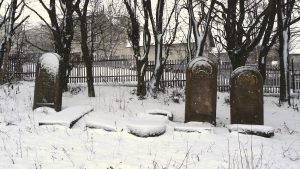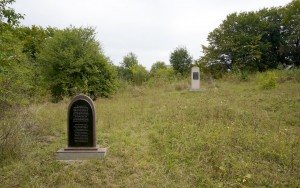![]() Ця сторінка також доступна українською.
Ця сторінка також доступна українською.
Introduction
In our article on Jewish traditions for death, burial, and mourning, we note that in Jewish law, a cemetery is a holy place more sacred even than a synagogue, and that the care of cemeteries is an essential religious and social responsibility. Rohatyn’s Jewish leaders established two cemeteries to serve the community, the first in the 17th century and the second in the 20th century. The cemeteries are located to the southeast and to the north of Rohatyn’s town center:
- the first or “old” Jewish cemetery: 49.4077N, 24.6159E (49°24’27.7″N 24°36’57.2″E)
- the second or “new” Jewish cemetery: 49.4199N, 24.6078E (49°25’11.6″N 24°36’28.1″E)
Both cemeteries were significantly damaged during the German occupation in World War II, but remain intact as burial grounds and sites of commemoration; details about each of the cemeteries are given below. In addition, Rohatyn Jewish Heritage is currently conducting active heritage preservation projects at both cemeteries:
Read about the Old Jewish Cemetery Rehabilitation Project
Read about the New Jewish Cemetery Rehabilitation Project
This article is part of a series on Rohatyn’s Jewish heritage on this website. To view the cemeteries as part of the broader Jewish heritage of the town and the district, see this modern interactive map of the heritage sites.
The “Old” Jewish Cemetery
Jews are recorded living and working in the Rohatyn area from the 16th century. Details of the origin and development of the first Jewish cemetery in Rohatyn are scarce, but permission to establish a cemetery was granted to Rohatyn Jews by Władysław IV Waza, King of the Polish Commonwealth, along with other municipal rights in 1633; those rights were confirmed 30 years later by King Jan II Kazimierz Waza. It is likely that the Jewish cemetery was established and in use before the adjacent wooden church of Saint Nicholas was built in 1729.
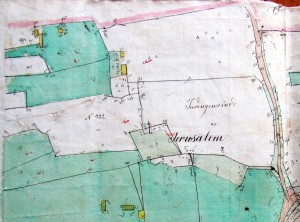
Rohatyn 1846 cadastral field sketch, sheet 15 (detail); original map from the Central State Historical Archives of Ukraine in Lviv (TsDIAL); photo © 2011 Jay Osborn.
The cemetery appears as a large land parcel in use on the 1846 cadastral survey field sketch of the town, near the large cross which marked the top of “Jerusalem hill” above town. The cemetery is marked with small triangles, indicating Jewish headstones. A much smaller adjacent plot is also marked as an added part of the Jewish cemetery.
Just south of the cemetery as it existed at the time is another parcel owned by the Jewish community of Rohatyn, probably reserved for cemetery expansion. In 1846 there were few structures around the cemetery; the wooden Saint Nicholas church on the next hill is not shown because it was in the adjacent cadastral area of Babintsi (former Babińce) to the east; the pink line on the map is the cadastral border.
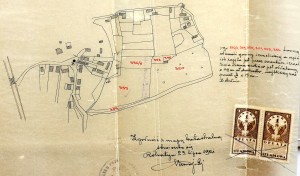
Rohatyn 1921 cadastral sketch of the old Jewish cemetery; original plan from the State Historical Archives of Ukraine in Ivano-Frankivsk; photo © 2013 Rabbi Moshe Leib Kolesnik.
Apart from these land records, no other information about the cemetery survives from Rohatyn’s time under the Austrian Empire, through World War I. In 1921, regional archival records indicate that the Jewish community was in need of additional cemetery space, i.e. that the original cemetery had reached capacity. Surveys were made of the cemetery and adjacent parcels, possibly as a study for expansion of the burial grounds. Eventually a new additional site to the north of town was chosen to extend the capacity of the burial grounds (see below).
Although there are no surviving grave maps or records of specific burials in the cemetery, there is plenty of secondary evidence useful in assessing the total number and density of graves and grave markers by the interwar period.The Jewish population of Rohatyn likely numbered more than 1000 by the early 19th century, and more than 2000 by the middle of the century, passing 3000 before 1880. Although deportations and destruction during the Great War diminished Rohatyn’s Jewish population, the community recovered and maintained a population of roughly 3000 for the next two decades until World War II. Through three centuries and many generations, thousands of Rohatyn’s Jews were buried in the cemetery, as were Jews from smaller communities without cemeteries of their own in the surrounding district.

Three pre-WWI views of Rohatyn’s old Jewish cemetery. Images courtesy Tomasz Wiśniewski (left and center) and the New York Public Library.
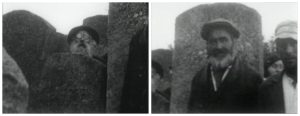
Two views of the old Jewish cemetery of Rohatyn. From a prewar film made by Fanny Holtzmann during her visit to Rohatyn and Lwów in the 1930s. Images courtesy the Digital Collection of the Center for Jewish History.
Historic photographs likely to be from Rohatyn’s cemetery give visual confirmation of the density of graves and of the stones which once marked them, as seen in the undated (likely WWI and interwar) views shown here. Even more remarkable, startling moving images of the cemetery are captured in a 30-second segment from a short amateur film taken in the early 1930s by Fanny Holtzmann, a Rohatyn descendant who visited the birthplace of her mother and grandfather while on business in Europe, and attended a funeral in the cemetery.
In 1991 our friend and colleague Dr. Sergey Kravtsov, Research Fellow for the Center for Jewish Art at the Hebrew University of Jerusalem in Israel, reviewed a valuable unnumbered composite collection of small photographic glass negatives from the interwar period at the Andrey Sheptytsky National Museum in Lviv and made contact prints of a selection of those images. Dr. Kravtsov informs us that the photographs were made by the Conservation Authority (Urząd konserwatorski) in Lviv. According to Alexander Ivanov and David E. Fishman in their Jewish Documentary Sources in Lviv Archives: A Guide (Wydawnictwo Uniwersytetu Wrocławskiego with «Дух і літера», 2023), the photograph collection was made between 1920 and 1939 by the photographers Rodosskii, Zbigniew Hornung, and Jozef Piotrowski. In 2023 Dr. Kravtsov shared with us his high-resolution scans of the prints from Rohatyn’s old Jewish cemetery, a total of six images, and in 2024 the Andrey Sheptytsky National Museum gave Rohatyn Jewish Heritage permission to present the images online (below).
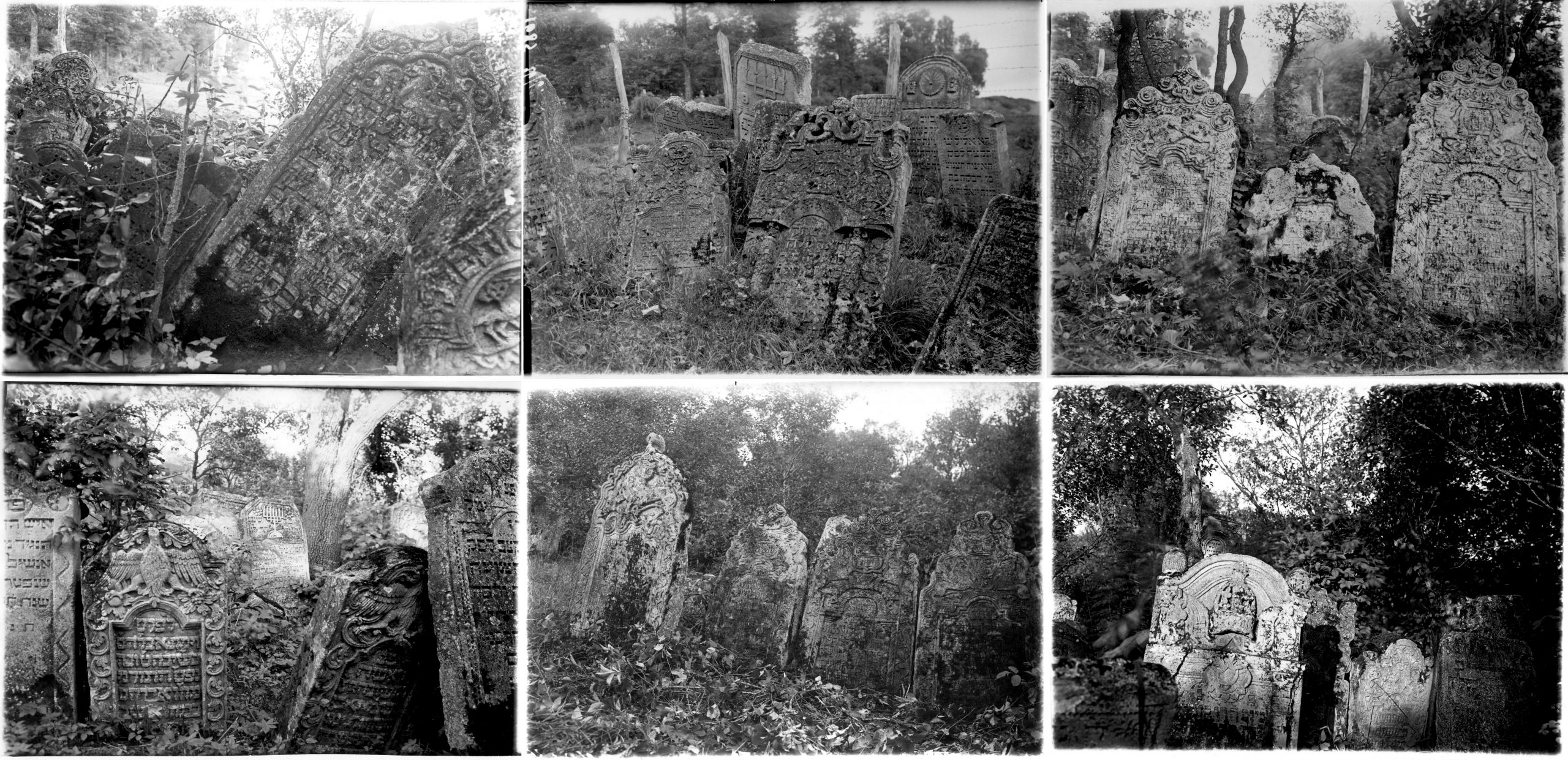
The six interwar images of Rohatyn’s old Jewish cemetery, as seen in the collection preserved at the Andrey Sheptytsky National Museum in Lviv.
Images courtesy of Dr. Sergey Kravtsov, with permission of the Museum.
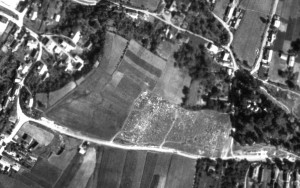
German military aerial photograph from 27 June 1944; original image in the US National Archives Cartography Department; copy acquired by Dr. Alex Feller.
During the German occupation of World War II, the old Jewish cemetery suffered a fate similar to many Jewish cemeteries all over the region: as described on our heritage page about Rohatyn’s Jewish grave markers, nearly all of the headstones, marking the graves of Jews buried here for hundreds of years, were removed and used as construction materials for roads, new building foundations, and other masonry and fill purposes, mostly disappearing under street surfaces and building facades. The cemetery was practically denuded of markers, and with them the physical memory of the Jewish community was destroyed at the same time.
In 1944, after the liquidation of the Rohatyn ghetto and only four weeks before the Soviet liberation of the region, German Luftwaffe airplanes flew over the area capturing aerial images of towns, roads, and features of military significance. The images of Rohatyn show the old Jewish cemetery, with residences on only a portion of its perimeter, and vestiges of its once-dense array of headstones.
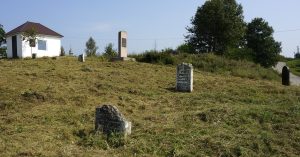
The top end of the old cemetery seen during a maintenance project. At rear, the closed ohel and the memorial stelæ; at front, two surviving headstones. Photo © 2018 RJH.
In the 1990s the cemetery became a new place of remembrance of the Jewish lives lost in WWII, and two memorial stelæ were erected near the top of the grounds. In 2011, an ohel was built over the graves of three rabbis of Rohatyn by an Israeli Hasidic organization working in central and eastern Europe; a smaller, open ohel was added some years later. The ohels are a reminder that the cemetery remains a burial place for nearly the entire pre-war Jewish community of Rohatyn, most of whose grave sites are unknown.
The cemetery is located about half a kilometer (a little over a quarter of a mile) from the town square, accessible from town on minor roads. The cemetery is roughly rectangular in shape, comprising about 1 hectare in area (around 2.5 acres). It is bounded on two sides by public roads, on a third by a driveway serving several houses; the north side is the edge of a steep downward slope to adjacent residential properties. The cemetery is near a high point in the town, and its gentle slope provides a wide panorama of Rohatyn and the river valley it overlooks.
Since the breakup of the Soviet Union and the establishment of independent Ukraine, the old Jewish cemetery has been owned and managed by the City of Rohatyn, which continues to preserve it as a historical burial ground. There are no signs in town indicating the location or significance of the cemetery, but it appears on a commercial street map of the town. The old cemetery does not have registration in the Ukrainian list of national or regional heritage sites, but Rohatyn Jewish Heritage is working with its attorneys to get the site listed for protection and recognition; in the meantime, the City and local residents respect the site and acknowledge the work we do there. Rohatyn Jewish Heritage also conducts regular maintenance events each year to clear wild vegetation and make light repairs to the fixed features of the cemetery; see our Old Jewish Cemetery Rehabilitation Project page for information about this work, and concepts for integration of the cemetery into the heritage fabric of modern Rohatyn.
In addition, the old cemetery is also now a gathering point for rediscovered headstone fragments which we are recovering from around town and returning in anticipation of a future memorial; the page on our Jewish Headstone Recovery project describes the effort and our progress to date. Even though only a small fraction of the substantial original number and variety of stones, these fragments with their epitaphs and symbols already help to tell the long and rich history of the Jewish community of Rohatyn.
The “New” Jewish Cemetery
From available archival records we cannot yet determine exactly when the new Jewish cemetery was opened in Rohatyn. Surveys of the old Jewish cemetery in 1921 plus letters between the Jewish community and regional civic and health authorities suggest that site was reaching capacity, and the Encyclopedia of Jewish Communities of Poland records that land was purchased for a second cemetery between 1910 and 1930 (despite the difficult economic situation in the region during and after World War I). So it is likely that the new cemetery was used for regular burials for less than 20 years, perhaps less than a decade, ending during World War II. Nonetheless, some prominent Jews of Rohatyn were buried in the new cemetery, as evidenced by the surviving headstones at the site, which are mostly of high-quality sandstone, several carved with delicate images, a few of which retain remnants of still visible gold, blue, and green colors.
We do not know how or even if the cemetery was damaged during the war. One large fallen stone is currently located within the cemetery perimeter but at a distance from the other stones; based on its design, Rabbi Kolesnik has suggested that this stone was likely uprooted and moved from its original location at the east side of the cemetery. There are less than twenty matzevot at the site today, all of them large and heavy; whether any smaller stones were removed around the same time that the old Jewish cemetery was desecrated is not known; in headstone recovery work around town to date few ‘late’ stones have been found.
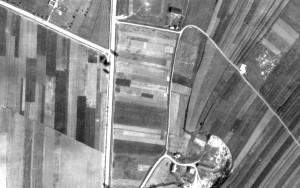
German military aerial photograph from 27 June 1944; original image in the US National Archives Cartography Department; copy acquired by Dr. Alex Feller.
There is photographic evidence that the new cemetery had seen a significant number of burials before and/or during the war: In 1944, after the liquidation of the Rohatyn ghetto and only four weeks before the Soviet liberation of the region, German Luftwaffe airplanes flew over the area capturing aerial images of towns, roads, and features of military significance. The images of Rohatyn show the new Jewish cemetery, isolated in agricultural fields, with what appear to be grave sites and headstones in rows covering a significant portion of the cemetery area; the cemetery is at the upper right in the image included here. Elsewhere in town, key buildings of the now-lost Jewish community were still intact at this time, though a number of houses appear destroyed near the center of town. An overlay of these historical photographs on modern satellite images of Rohatyn show that the cemetery outline has changed since the war (along with roads and many other features of the town).
In the 1990s the cemetery became a new place of remembrance of the Jewish lives lost in WWII, and a new memorial stele was erected by survivors of the Holocaust in Rohatyn and other descendants of Rohatyn Jews. Also beginning in the 1990s and continuing with our Jewish Headstone Recovery project from 2011, the new cemetery became a gathering point for rediscovered Jewish headstone fragments, but because nearly all recovered stones date from before the new cemetery was inaugurated, since 2015 those stones have been moved to the old cemetery for a future memorial. In 2013, on the initiative and with the support of Rohatyn Jewish Heritage and Jewish descendants, the bones of a dozen unidentified individuals (likely Jewish, and died during WWII) were buried in the new cemetery by representatives of the local Ukrainian Greek Catholic church and the Jewish community of Ivano-Frankivsk; a monument was placed over that grave in 2015.
The surviving cemetery is 1.5 kilometers (about one mile) due north of the town square, accessible from town on primary roads. The cemetery site is almost square in shape, comprising about 1/3 hectare in area (around three-quarter of an acre). It is bounded on one side by a public road, on another by a driveway serving several houses; the entrance is located at the south side, adjacent to a woodworking shop.
Since the breakup of the Soviet Union and the establishment of independent Ukraine, the new Jewish cemetery has been owned and managed by the City of Rohatyn, which continues to preserve it as a historical burial ground. There are no signs in town indicating the location or significance of the cemetery, but it appears on a commercial street map of the town. The new cemetery does not have registration in the Ukrainian list of national or regional heritage sites, but Rohatyn Jewish Heritage is working with its attorneys to get the site listed for protection and recognition; in the meantime, the City and local residents respect the site and acknowledge the work we do there. Rohatyn Jewish Heritage also conducts regular maintenance events each year to clear wild vegetation and make light repairs to the fixed features of the cemetery; see our New Jewish Cemetery Rehabilitation Project page for information about this work, and concepts for integration of the cemetery into the heritage fabric of modern Rohatyn.

